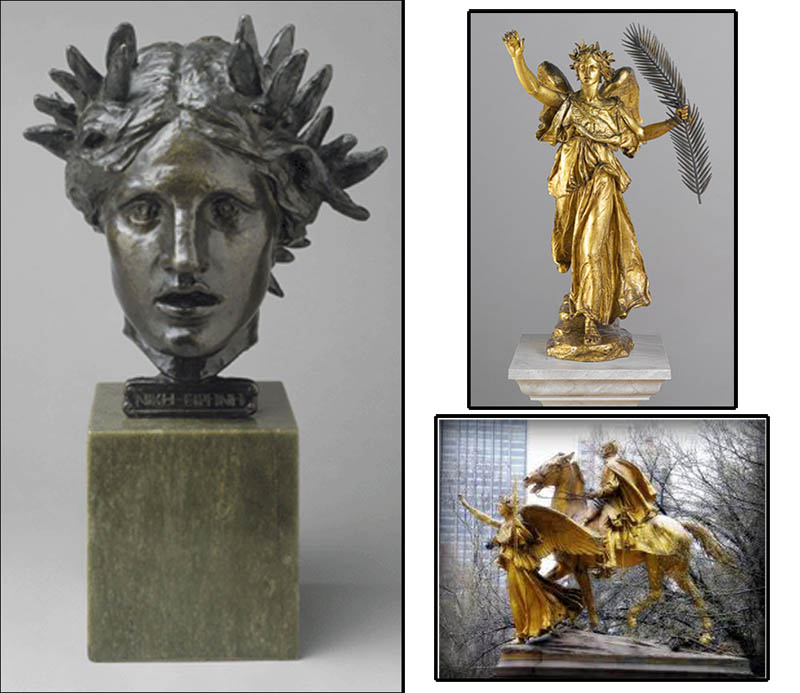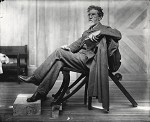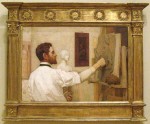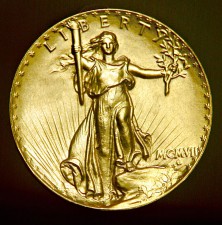

Augustus Saint-Gaudens
Irish, 1848-1907 (active USA)
Head of Victory, 1903
gilded bronze
8 1/4 x 7 1/2 x 6 in.
SBMA, Museum Purchase, with funds provided by the Suzette and Eugene Davidson Fund
1992.70

"Augustus Saint-Gaudens,” 1886, this replica, 1908, by his friend, Kenyon Cox, shows the sculptor at work in his 36th Street, New York City, studio on his bas-relief portrait of William Merritt Chase. It conveys the vigor and intensity of the artist as he applies a wad of clay to his depiction. Cox painted this larger version after his first canvas was destroyed in the 1904 fire in Saint-Gaudens's Cornish, N.H. studio. Metropolitan Museum of Art, NYC.
“What garlic is to salad, insanity is to art.“ - Augustus Saint-Gaudens
RESEARCH PAPER
Standing on a tall pedestal is the small, gilded-bronze sculpture called Head of Victory, communicating a sense of power as if magnifying its actual size as it forces itself upon its viewer. The fact is that this figure is actually a scaled down model of a rather large female angel who is the front part of a famous gilded bronze equestrian monument by Augustus Saint Gaudens. He was commissioned to create a memorial tribute to General William Tecumseh Sherman, a Civil War leader who commanded his Union forces on a crushing campaign through the South. This eight foot tall angel, the artist's visualization of a symbolic peace with victory, appears to be rushing forward, leading the General on his path to destiny. Far from being a delicate angel, she has a lithe, Amazonian body. She is called Victory and is shown as a powerful woman in purposeful stride with her right arm raised high and her mouth open as if to say, 'Make way for a hero.'
She is such an integral part of the composition of the equestrian monument that "her presence pervades and colors the whole (p. 326, Wilkinson).” Saint Gaudens was paid $45,000 for the completed monument, which was begun 1892, and cast in bronze in Paris in 1903. Southerners were displeased with the General's being honored, especially since the horse on which he's mounted is trampling on a branch of Georgia pine. They are recorded as saying, “How like a Northerner to send a woman before him so he wouldn't get shot."
Augustus Saint Gaudens idealized women, and never tired of typically creating them as long, narrow-faced, more rectangular than oval, much like his mother's face. They usually had a straight, high-bridged very classical Greek nose, short curving full lips, and a high forehead as he had seen on Greek coins. The eyes were typically deep set and fiery to help create the mood. He found a Swedish model that had such a face as well as a long, lithe body. Her name was Alberta Hulgren, but he called her Davida, after Michelangelo's David. In time they became lovers and she remained his model and mistress for almost 30 years even though he was a married man at that time.
Augustus Saint Gaudens was born in Ireland to an Irish mother and a French father. Their family emigrated to Boston and then New York when Augustus was an infant. Showing great artistic promise, Augustus was taken from school at the age of 13 and apprenticed to a cameo maker. In a short time, he was making animal and human cameo heads in shell and stone by himself. (He often fell back on this skill during his early years to earn money, as he was frequently unable to support himself.) As he often had conflicts with his master teacher, his parents decided to send him to study art in Europe. He spent three years in Paris, 1867-70, and three years in Rome, 1870-73. In 1874 he returned to America.
He always preferred the Renaissance artists, and the classical styles formed the core of his work. By the mid 1880's, Saint Gaudens was considered a towering figure in the art world. He was busy in America and France and had completed many commissions for portrait statues, bas reliefs, and medallions. Since he maintained homes for both of his families, as well as studios in New York and Paris, he was always short of cash. He decided to make a series of a smaller version of the Head of Victory for a Christmas sale at Tiffany’s, which sold for $90 each. Since his wife objected strenuously to his using Davida as the model for the new image, he used for his model Alice Butler, a young lady living in Windsor, VT. On this small sculpture, the facial expression is the same as on Victory, but now the hair is held tight to the head in a bun and is crowned with olive leaves rather than laurel leaves (Pp. 316, 322, Tharpe).
A remark by the German/Italian composer Johann Adolph Hasse about Saint Gaudens' work has relevance today--"Augustus possesses that mysterious quality that made it look easy--that which he achieved, this ultimate facility, his sculptures." (p. 185 Wilkinson) After producing a huge body of work in his lifetime, Saint Gaudens died of stomach cancer in 1907. John Wilmerding, Director of the National Gallery ranked Saint Gaudens with the artistic giants of his time--Auguste Rodin and Thomas Eakins (p. XV.Wilkinson). The Head of Victory is more than a head because it achieves art's true goal of capturing some universal quality, yet preserving a moment of time while still reflecting an attitude and mood--thus the viewer's experience is more than a mere look at a famous sculpture; rather it's a precious exposure to an artist's thoughtful creation of a powerful woman in an eight inch round head.
Submitted to the Docent Council by Eunice Drell.
Bibliography
Wilkinson, Burke, UNCOMMON CLAY, The life and works of Augustus Saint
Gaudens, Harcourt Brace Jovanovich, Publishers, 1985
Tharp, Louise Hall, SAINT-GAUDENS AND THE GILDED ERA, Little, Brown &
Co., 1969

Twenty-Dollar Gold Piece, 1905-7, 1 5/16th inch diameter. Saint Gaudens told President Roosevelt that his idea for the design of the twenty-dollar gold piece was "to make it a living thing and typical of progress." The coin is considered by many collectors to be the most beautiful coin ever minted in the United States. A limited number of coins were produced using a high relief design, but the high relief made the coin difficult to stack. Charles E. Barber, the Mint engraver, insisted that a lower relief version be made. In December 1907 a "business issue" of the coin was first struck and was minted until 1933.
SBMA CURATORIAL LABELS
Saint-Gaudens was the leading American sculptor of his generation, responsible for many major public monuments in bronze. This small head of a classical personification of Victory is related to one of the last and most famous of his public commissions: an equestrian sculpture of General Tecumseh Sherman, whose victory signaled the end of the American civil war. Saint-Gaudens completed the sculpture in 1903 and it still stands at Fifth Avenue and East 60th Street in New York. The fierce expression of Victory with her mouth agape in awe of the future that will unfold with the coming of peace recalls French monumental sculptures of the previous age, such as François Rude’s La Marseillaise, which Saint-Gaudens would have known through his years of study at the École des beaux-arts in Paris.
- Ridley-Tree Reopening, 2021
